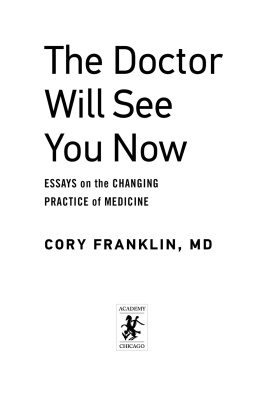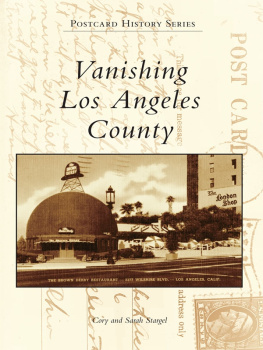Cory Franklin MD - Cook County ICU: 30 Years of Unforgettable Patients and Odd Cases
Here you can read online Cory Franklin MD - Cook County ICU: 30 Years of Unforgettable Patients and Odd Cases full text of the book (entire story) in english for free. Download pdf and epub, get meaning, cover and reviews about this ebook. year: 2015, publisher: Chicago Review Press, genre: Detective and thriller. Description of the work, (preface) as well as reviews are available. Best literature library LitArk.com created for fans of good reading and offers a wide selection of genres:
Romance novel
Science fiction
Adventure
Detective
Science
History
Home and family
Prose
Art
Politics
Computer
Non-fiction
Religion
Business
Children
Humor
Choose a favorite category and find really read worthwhile books. Enjoy immersion in the world of imagination, feel the emotions of the characters or learn something new for yourself, make an fascinating discovery.

- Book:Cook County ICU: 30 Years of Unforgettable Patients and Odd Cases
- Author:
- Publisher:Chicago Review Press
- Genre:
- Year:2015
- Rating:4 / 5
- Favourites:Add to favourites
- Your mark:
- 80
- 1
- 2
- 3
- 4
- 5
Cook County ICU: 30 Years of Unforgettable Patients and Odd Cases: summary, description and annotation
We offer to read an annotation, description, summary or preface (depends on what the author of the book "Cook County ICU: 30 Years of Unforgettable Patients and Odd Cases" wrote himself). If you haven't found the necessary information about the book — write in the comments, we will try to find it.
Cook County ICU: 30 Years of Unforgettable Patients and Odd Cases — read online for free the complete book (whole text) full work
Below is the text of the book, divided by pages. System saving the place of the last page read, allows you to conveniently read the book "Cook County ICU: 30 Years of Unforgettable Patients and Odd Cases" online for free, without having to search again every time where you left off. Put a bookmark, and you can go to the page where you finished reading at any time.
Font size:
Interval:
Bookmark:

Copyright 2015 by Cory Franklin
All rights reserved
Published by Academy Chicago Publishers
An imprint of Chicago Review Press Incorporated
814 North Franklin Street
Chicago, Illinois 60610
ISBN 978-0-89733-928-5
Sections of this book have previously appeared in the Chicago Tribune: chapter 6 as Making Assumptions, February 5, 2014; a portion of chapter 7 as When a White Man Goes to a Black Mans Funeral, September 12, 2014; portions of chapter 14 as One Enchanted Moment, June 14, 1996, and Elvis Has Definitely Left the Building, January 11, 2015; and a portion of chapter 18 as Caring for the Notorious Patient, June 13, 2013. Other sections have appeared in Chicago Life Magazine: chapter 20 as Yule Sample, December 9, 2009; and chapter 24 as Health Without Wealth, December 7, 2008.
Library of Congress Cataloging-in-Publication Data
Franklin, Cory M.
Cook County ICU: 30 years of unforgettable patients and odd cases / Cory Franklin, MD.
pages cm
ISBN 978-0-89733-925-4
1. John H. Stroger, Jr., Hospital of Cook County (Chicago, Ill.) 2. Intensive care unitsIllinoisCook County. 3. Intensive care unitsIllinoisChicago. 4. Intensive care unitsIllinoisChicagoAnecdotes. 5. HospitalsIllinoisChicagoAnecdotes. I. Title. II. Title: Cook County Intensive Care Unit.
RA975.5.I56F73 2015
362.17'4097731dc23
2015018606
Cover design: Andrew Brozyna, AJB Design Inc.
Cover images: Shutterstock
Interior design: PerfecType, Nashville, TN
Interior layout: Nord Compo
Printed in the United States of America
5 4 3 2 1
This digital document has been produced by Nord Compo.
Life is short, and art long; the crisis fleeting; experience perilous, and decision difficult.
HIPPOCRATES
O NE COULD ARGUE that no profession has an older and richer literary tradition than medicine, and it is a tradition that has no geographical boundaries. Is it possible to say which country has produced the best writing about doctors and patients? Certainly Russia can make a claim. Tolstoy, Pasternak, Turgenev, and Dostoyevsky, among others, all wrote marvelously on the subject of medicine. But were they superior to the EnglishConan Doyle, Emily Bront, Thomas Hardy, George Orwell, et al.? And in any discussion of medicine in literature, the American literary canon bears considerationHemingway, Fitzgerald, Faulkner, Sontag. Those authors are just part of an impressively long American list, which carries on in the current era with people like Sherwin Nuland and Richard Seltzer.
My point is not to create some specious literary salon argument, but to illustrate the universality of the powerful emotions and personalities of the doctor/patient relationship. And as Norman Cousins observed in his 1982 classic The Physician in Literature, this is best illustrated in the anecdote: the quotidian accounts from real life that occur any place where patients encounter doctorshospitals, clinics, or the office. Cousins wrote:
Writers are natural producers of anecdotes. This is what they are supposed to be. The anecdote is their stock in trade. We absorb these anecdotes and we learn from them. I now give a course in a medical school on the physician as perceived by the writer. Nothing is more interesting to me in that course than the willingness of students to take fictional anecdotes more seriously than they do examples from real life. Fortunately, by the end of the course, many of them come to recognize that even isolated incidents in human experiences can be repeated and are therefore significant.
Luckily for me when I undertook this book to recount my anecdotes, it was not necessary to have the literary skills of the aforementioned great authors. Over four decades, I was a medical student, medical resident in training, and then an intensive care and clinic physician at Cook County Hospital in Chicago. (Reflecting the values of our current age, the hospital has since been renamed John Stroger Hospital, after not a doctor but a politician.) Before that, my father worked at Cook County as an attending physician in the hospitals magnificent decade after World War II. So except for a brief hiatus in the turbulent 1960s, my familys experience covered most of the second half of the twentieth century and the first decade of the twenty-firstfifty years at one of Americas premier urban hospitals.
Located on the citys Near West Side, Cook County Hospital has a storied history and is perhaps as famous as any hospital in the world. During my training, I received patients from six continents who traveled specifically to be treated at Cook County. (Regrettably, to the best of my knowledge no patient from Antarctica ever arrived for care at County.) The hospital was originally built to treat cholera patients in the middle of the nineteenth century, but the famous building on West Harrison Street, the facade of which still stands today, was built in 1916. One of the best historical accounts of the hospital is The Old Lady of Harrison Street, written by the eminent surgeon/author John Raffensperger, a medical student of my father, and my teacher when I was a medical student. Such was the tradition of care the hospital encouraged.
In terms of medical and nursing training, Cook County was one of the worlds great teaching hospitals, especially in the 1940s and 1950s, when it was a nearly four-thousand-bed facility. There, doctors and nurses learned through clinical experience and seeing large numbers of patients, supplemented by reading books and listening to professors. University and community hospitals of the era were not so fortunate to have the same clinical volume. Because the best and brightest from all over the world were attracted to Cook County, it became an international center of medical instruction and research. A significant percentage of the American doctors and nurses who trained in the years after the war either spent time at County or learned from people who did. One of the worlds first blood banks was opened there, and a number of surgical techniques were first pioneered there. The hospital developed a worldwide reputation in trauma, burn care, AIDS treatment, and intensive care, the last being the field that I elected to pursue for my career.
Just as important as their intellectual commitment, the doctors and nurses who were attracted to work there were fantastically dedicated and devoted to caring for patients. Most of them demonstrated a real love of humanity. The hospital was located in a poor neighborhood and was always available to everyone, regardless of ability to pay. It was one of the worlds foremost charity hospitals for the poor and destitute. Many of these patients were brought in from the nearby neighborhood, but County also accepted great numbers of patients from other hospitals. These patients were generally transferred there because they were unable to pay for care. Nor was this an exclusively local phenomenon; poor patients not infrequently came from hospitals as far away as Mississippi and California.
The rich ethnic mixture of Chicago, then the countrys second-largest city, made the hospital a veritable melting pot. In the mid-twentieth century, the wards were filled with immigrants from Eastern Europe, Italy, and Ireland. Later the hospital became the primary health facility for thousands of African Americans who traveled by rail, bus, and car to Chicago as part of the great postwar migrations from the South. A sixteen-hour journey by a sick patient from Clarksdale or Greenville, Mississippi, to the hospital on Harrison Street in Chicago was not unusual. It was no exaggeration to say that Cook County was the hospital most trusted by the poor of the Mississippi Delta. (Although the hospital today is much smaller and has lost much of its intellectual luster, the phenomenon of poor patients coming from far away continues. Today, patients routinely come from Mexico, Central America, and South Asia; Italian and Polish translators are no longer as necessary as ones fluent in Spanish and Urdu.)
Font size:
Interval:
Bookmark:
Similar books «Cook County ICU: 30 Years of Unforgettable Patients and Odd Cases»
Look at similar books to Cook County ICU: 30 Years of Unforgettable Patients and Odd Cases. We have selected literature similar in name and meaning in the hope of providing readers with more options to find new, interesting, not yet read works.
Discussion, reviews of the book Cook County ICU: 30 Years of Unforgettable Patients and Odd Cases and just readers' own opinions. Leave your comments, write what you think about the work, its meaning or the main characters. Specify what exactly you liked and what you didn't like, and why you think so.






